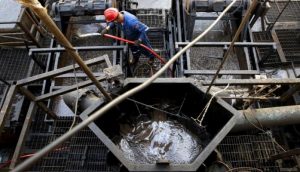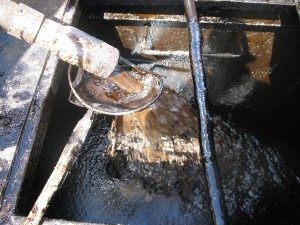Drilling data management systems market to grow 12% by 2020 – Technavio
Areas in Middle East, Gulf of Mexico, and North Sea seeing drop in production rates over past few years

The flow of drilling mud is seen in a container while an oilfield worker works on a drilling rig at an oil well operated by Venezuela’s state oil company PDVSA, in the oil rich Orinoco belt, near Cabrutica at the state of Anzoategui April 16, 2015. REUTERS/Carlos Garcia Rawlins
LONDON – Technavio analysts forecast the global drilling data management systems market to grow at a compound annual growth rate (CAGR) of around 12 per cent during the forecast period, according to their latest report.
The research study covers the present scenario and growth prospects of the global drilling data management systems market for 2016-2020.
The report examines the key emerging trends and their influence on the current and future market scenarios.
It also presents the vendor landscape with an analysis of innovations in the current market and how they might prove to be game-changers in the future.
Strong focus on asset optimization
Over the years, due to the advancement in technology, the capital costs involved in the production of oil have come down. However, a rise in the operational costs component has forced the global oil and gas producers to focus their attention on optimization of the resources.
This is exactly where the use of data capturing and analytics can contribute in a significant way. One of the major focus areas in the upstream segment is the drilling and cementing stage, wherein the optimization methods can have a long-standing effect on the entire project life cycle.
The use of supervisory control and data acquisition in the drilling and completion operations is widely accepted throughout the industry.
However, in today’s scenario, the importance lies with the use of this data and improving future business decisions. Some of the key aspects of the drilling operations, where the use of data management is highly beneficial include:
- Building and assessment of better drilling models
- Improvement in the drilling accuracy and safety
- Reduction in the over Non-Productive Time (NPT)
- Improvement in the real-time decision making process
- Improvement in the predictive maintenance scheduling and efficiency
Improvement in well control
The drilling procedure includes the intrusion of a drill bit into the formation, which sometimes may be thousands of feet below the surface. The formation pressure experienced at these depths is immense.
Thus, one of the most significant risks to the drilling process and the well is well collapse and well blowout. This puts the associated resources, equipment, investment, and personnel at high risk.
Thus, well control is one of the key aspects that needs to be kept in mind during drilling operations.
The use of data management systems is one of the potential tools that can help address this issue. The physical components of these data management systems include the installation of actual sensors in the wellbore, which help in the data acquisition.
These sensors measure various key parameters such as pressure, temperature, well trajectory, and torque on drill string to help identify the current state of the drilling operations.
However, the potential of the data has not been harnessed completely to date. With new advances in the sector, such as new data acquisition, storage, and processing solutions, the data can be analyzed and used for trend analysis and data visualization.
According to Sayani Roy, an industry expert at Technavio for oil and gas research, “Big data solutions can help enterprises keep track of the enormous volume of big data being generated and use it effectively. This will serve a two-fold use of optimizing the real-time decision making process and improve the predictability of the operations, thus providing better well control capabilities.”
End of era of easy oil
The era of easy oil is coming to an end. Established areas like the Middle East, Gulf of Mexico, and North Sea areas have started witnessing reduction in the rates of production in the past few years.
This has led the energy companies to move out in search of new resources, to areas like the Yamal basin in Russia, Andaman Sea in the Indian sub-continent, and most significantly regions in the Arctic and Antarctic.
The major issue with the shift to these areas is that there exists very little data regarding the formation characteristics of these areas.
Decades of activities in the older regions meant there were enough data and trends regarding the formation behavior, reducing the risks to a large extent.
There are new technologies in the market that enable the monitoring of drilling activities on a very detailed scale. These systems are expected to capture well behavior while drilling through the permafrost sub-formations in the Arctic and the Yamal regions that might involve deep-water or ultra-deep-water drilling activities.
The importance of data is significant even in the move towards unconventional resources of hydrocarbons such as gas hydrates and coal bed methane.
Digitization of drilling activities facilitate automatic, real-time, and remotely controlled operations, employing minimum manual involvement.
Advanced communication systems and video surveillance enable a connection between remote project sites and the workforce.
These enhance operational efficiency and productivity, while minimizing issues of workforce safety. As an example, certain European countries such as Norway have mandated all companies planning new offshore E&P facilities to create subsea infrastructure that can be monitored from an onshore site.
These policies are partly designed to counter workforce injuries caused by frequent storms in the Norwegian North Sea.
“With very less historical data available from actual operations, the most important focus in these operations lie not only with data capturing but also with data analysis. The role of big data analysis is critical in this aspect. The huge amount of data generated can be processed by service providers and consulting companies, which will result in the generation of trends and predictive models for operating in these regions,” says Sayani.

Ph: 432-978-5096 Website: www.mapleleafmarketinginc.com








